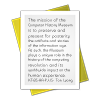Description
Steve Naroff was born in Poughkeepsie NY, 1961, of Ashkenazi Jewish parentage. His father was a jazz musician, conductor, and educator. Naroff’s childhood was spent in the Bronx, and later in the Spring Valley suburbs of New York where his father taught high school music. Naroff began playing classical clarinet at the age of six, and later jazz saxophone. Naroff received his degree in Computer Science from SUNY Oswego in 1983, with a minor in Music. His first job out of college was at Henckels, Haas & Brown (later HHB-Softron), working on Computer Aided Design and Test systems, where he had his first exposure to Unix and C. After reading about Smalltalk in Alan Kay’s 1977 Scientific American article “Microelectronics and the Personal Computer,” Naroff decided to move to Cericor in Salt Lake City, where he lead the design of graphical circuit design systems, using the language MAINSAIL, which used a dynamic runtime like Smalltalk. Naroff stayed on for a year after HP’s acquisition of Cericor, but eventually left after disagreeing with HP’s decision to port the MAILSAIL-based product to C++, which lacked the dynamic runtime. After meeting Brad Cox and Tom Love at an OOPSLA conference, Naroff joined their startup PPI in 1986, which was later renamed Stepstone. Naroff’s first task was to port the Objective-C translator to various platforms including HP-UX and Apollo, and documenting the design and implementation. After NeXT became a user of Objective-C, Naroff became the main engineer fixing Objective-C for NeXT’s needs, which he felt was not given sufficient attention at Stepstone. By 1988, Naroff had decided to join NeXT outright. At NeXT, Naroff integrated Objective-C into the GNU C Compiler, integrated C++ with Objective-C in GCC to support Lotus’ Improv spreadsheet, and added the “categories” feature to help support the graphical Interface Builder development tool. Naroff became the manager of NeXT’s Development Tools team, leading the development of an Objective-C parsing framework called DevKit, and collaborating with Bertrand Serlet and Blaine Garst on adding the “protocols” feature to Objective-C. Naroff took a break from NeXT in 1994, working at IBM evaluating various object-oriented platform plays. Naroff returned to NeXT in 1995 to create its Objective-C to Java bridge. After NeXT’s acquisition by Apple, Naroff became Apple’s Director of Java technologies and developer tools, driving Apple’s Java strategy through its transition from Mac OS 9 to OS X, merging NeXT and Apple’s developer tools teams, and managing Apple’s relationship with Metrowerks, a key third party tools developer. Naroff stepped down from management in 2002 to develop Xcode, Apple’s Integrated Development Environment (IDE), led development of Objective-C 2.0 from 2005-2007, and led the development of the LLVM/Clang C compiler front-end from 2007-2010.
Date
2018-10-08
Contributor
|
Hsu, Hansen, Interviewer
|
|
Naroff, Steve, Interviewee
|
Publisher
Computer History Museum
Place of Publication
Mountain View, Ca
Extent
76 p.
Format
PDF
Category
Transcription
Subject
Objective-C (computer programming language); MAINSAIL; Stepstone; NeXT; Apple; Objective-C++ (computer programming language); Categories; Protocols; Java; Interface Builder; Xcode; LLVM; Cox, Brad; Love, Tom; Stallman, Richard; Jobs, Steve; Serlet, Bertrand; Garst, Blaine; Tevanian, Avie
Collection Title
CHM Oral History
Credit
Computer History Museum


